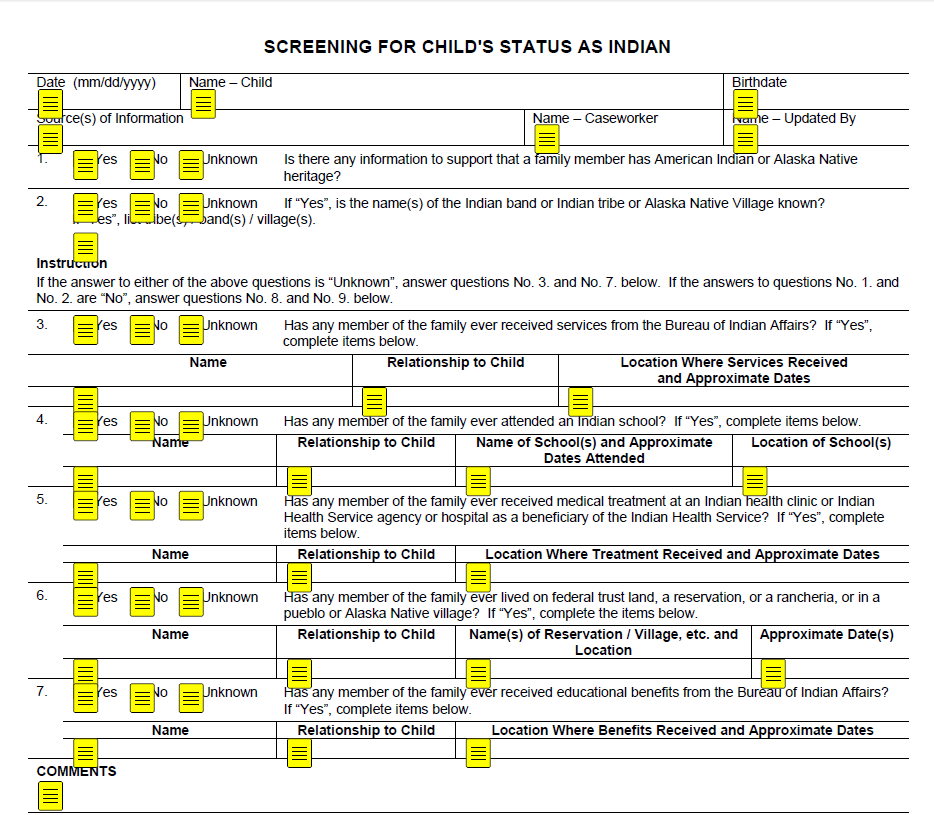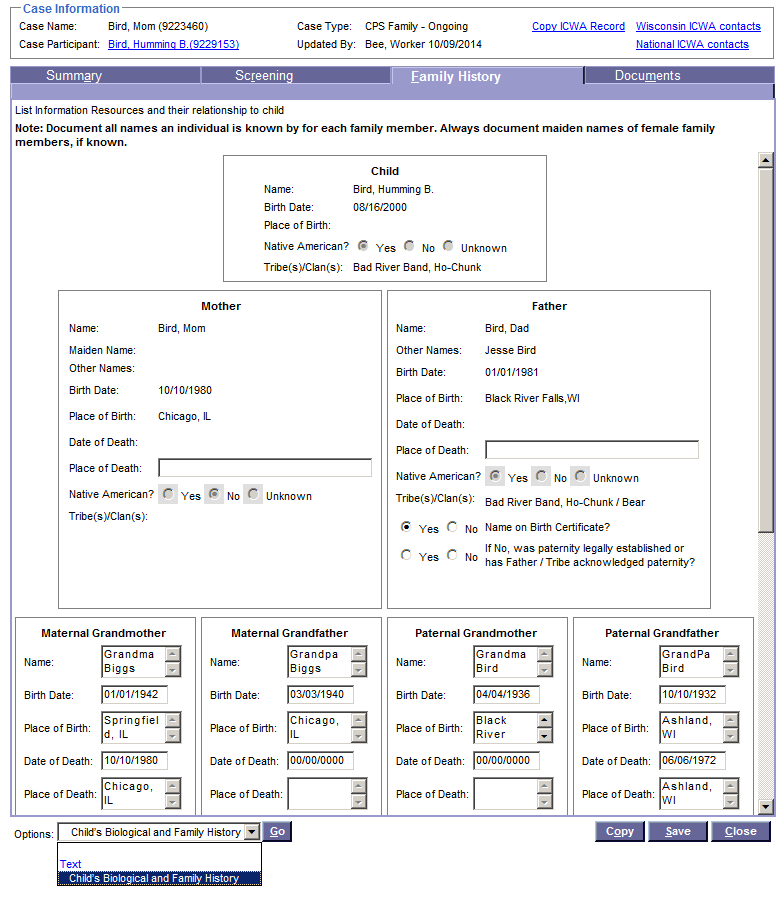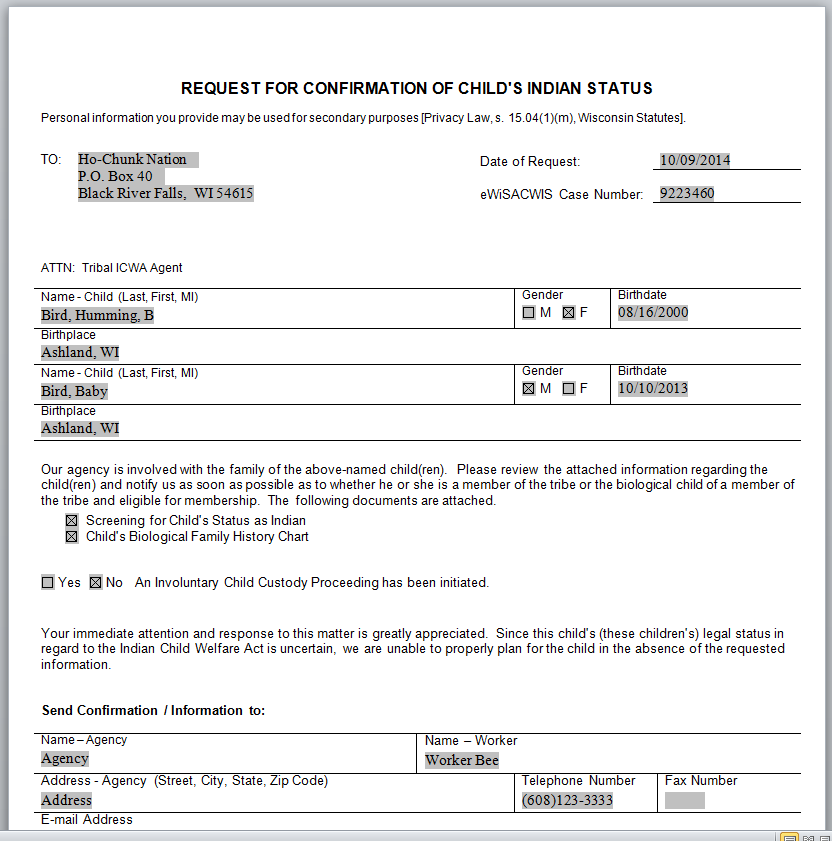Identification
Early identification of an Indian child is crucial in applying W/ICWA. Whether or not a child is a member or eligible for membership is determined by the tribe and each tribe determines their own eligibility criteria. A worker should provide each tribe with thorough and accurate information in order to ensure proper identification of Indian children. There are several documents in eWiSACWIS to assist with capturing accurate information such as the Biological Family History form and the Screening for Child’s Status as an Indian.
In order to comply with the federal regulations that went into effect in December of 2016, the caseworker must be prepared to provide written report or oral testimony as to the agency’s due diligence to identify and work with all tribes with which the child is either a member or eligible for membership.
- Make sure you continue to ask if child has Native American membership/enrollment throughout the case—especially at the point of any case transfer to another worker. Do not assume that the worker previously handling the case has already asked these questions or received the information.
- It will help to ask all collateral contacts, including extended relatives. (see Active Efforts tab regarding confidentiality)
- If a child’s eligibility status changes, Initial Notice will be required (See Notice page). This could occur if the family had not been previously asked about their Indian heritage or if the tribe changes its membership requirements.
- Should eligibility information change, remember to update the Person Management Tab to reflect this change.
- Establishing paternity and exploring any paternal Native American ancestry is also crucial in identifying Indian children. Example: A family was assigned a new case manager after a year of case management services. The new case manager noticed Native American artwork throughout the home and complimented the home’s décor. The parent’s response was great pride of her Native American Heritage that had not been previously explored. The child was a tribal member which required the new worker to implement WICWA mandates.
An Indian child is defined, by statute, as an unmarried person under the age of 18 who is:
- A member of a federally recognized tribe OR
- Eligible for membership of a federally recognized tribe AND the biological child of a member of a tribe.
In order to determine if a child is an Indian Child, thoroughly complete the following documents and send to the tribal agent for each potential tribe. Be sure to be thorough and accurate!
- Screening for Child’s Status as Indian
- Child’s Biological History form
- Try to be as complete as possible. Each tribe may need extended relative information to determine eligibility.
- Include enough family history that may identify an enrolled tribal member.
- Include maiden names for any married person, if possible.
- Ensure accurate spelling and dates of births for all individuals.
- Encourage the family to talk to other family members and/or community members if they do not know the names of grandparents, great-grandparents, etc. in order to assist you in filling out this form as completely as possible.
- Request for Confirmation of Child’s Indian Status
- Completely fill out this form and send it to all tribes in which the child may be a member or eligible for membership.
- The Child’s Biological Family History Form and the Screening for Child’s Status as Indian should accompany this form to assist the tribe in making a determination of the child’s membership status.
- The request and the additional documentation does not have to be sent by registered mail unless it is accompanied by the initial notice. They can be sent by regular mail, fax or email. Best practice would be to contact the tribe and ask how they prefer to receive the documents.
Tip: This should be completed for EVERY child during the Initial Assessment as it documents a worker’s attempt to identify an Indian child. This form is a tool to assist in identifying an Indian child and should be reviewed with family members, including extended relatives.
The template must be launched through the Options drop down menu to be recognized as completed in eWiSACWIS.
Tip:
You can find this form in eWiSACWIS by going to the third tab, Family History. From the Options drop-down, select Child’s Biological and Family History and click Go.
Tip:
You can find this form in eWiSACWIS by going to Tab 4 - Documents Tab. To create any of these documents, click on the Insert button. The Document Select page will open. Select the document to create and click Continue.
- W/ICWA applies!
- Immediate engagement with the tribal social worker is crucial during assessment and case planning!
- Treat the case as if WICWA applies until it is determined otherwise.
- Be sure to reach out to both parents, extended relatives, and your collateral contacts to assist with the Screening for Child’s Status as Indian and Biological Family History forms
- If you are struggling to reach the tribe:
- Search for the appropriate contact information in the Federal Registry.
- Contact the Wisconsin Department of Children and Families Tribal Affairs Specialist at dcfwicwa@wisconsin.gov
- If you are not sure which tribe to contact, see “Contacting the Tribe” section of this online resource.
Refer to the Does ICWA Apply to a State Proceeding? flowchart, and make sure the following thresholds have been met.
Back to top


